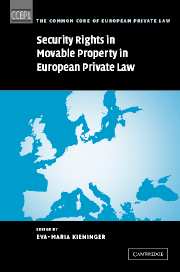Book contents
- Frontmatter
- Contents
- General editors' preface
- Preface
- List of contributors
- Table of cases cited by name
- Table of legislation
- Part I Introduction and context
- List of abbreviations
- 1 Introduction: security rights in movable property within the common market and the approach of the study
- 2 A labyrinth of creditors: a short introduction to the history of security interests in goods
- 3 Security in movables in the United States – Uniform Commercial Code Article 9: a basis for comparison
- 4 The English law of security: creditor-friendly but unreformed
- 5 The European Bank for Reconstruction and Development's Secured Transactions Project: a model law and ten core principles for a modern secured transactions law in countries of Central and Eastern Europe (and elsewhere!)
- Part II The case studies
- Index by country
- Index by subject
1 - Introduction: security rights in movable property within the common market and the approach of the study
Published online by Cambridge University Press: 23 December 2009
- Frontmatter
- Contents
- General editors' preface
- Preface
- List of contributors
- Table of cases cited by name
- Table of legislation
- Part I Introduction and context
- List of abbreviations
- 1 Introduction: security rights in movable property within the common market and the approach of the study
- 2 A labyrinth of creditors: a short introduction to the history of security interests in goods
- 3 Security in movables in the United States – Uniform Commercial Code Article 9: a basis for comparison
- 4 The English law of security: creditor-friendly but unreformed
- 5 The European Bank for Reconstruction and Development's Secured Transactions Project: a model law and ten core principles for a modern secured transactions law in countries of Central and Eastern Europe (and elsewhere!)
- Part II The case studies
- Index by country
- Index by subject
Summary
The topic of ‘Security Rights in Movable Property’ does not need a long introduction. Earlier comparative studies in this field have shown the divergencies with respect to both principle and the practical outcome of cases. Therefore, and because of the pressing need for some measure of harmonisation, it is not surprising that the Common Core Project has chosen the topic as one of its first sub-projects. The task of exploring in greater detail the similarities and differences between the European legal systems in the field of security over movables will be undertaken in Part II of this study. The purpose of the following short introduction is to summarise the economic reasons behind the creation of security interests, to give a short overview of the main divergencies and the problems that are created for international and more specifically for intracommunity trade through such divergencies combined with the present rules of private international law, and to outline the previous attempts at harmonisation and unification as well as the main arguments usually advanced against their feasibility (part A). Part B will explain the specific approach of the present study which not only differs from the usual type of comparative investigation but also deviates – albeit to a lesser extent – from other studies within the Common Core Project.
- Type
- Chapter
- Information
- Publisher: Cambridge University PressPrint publication year: 2004
- 3
- Cited by



